Independent Building Surveyors
We are independent surveyors who carry out specific defects reports relating to condensation, dampness, wet rot, dry rot, woodworm and other defects such as movement and cracking. We can offer residential building reports, structural surveys, Home Buyers Reports, commercial building surveys, schedules of condition, etc. We also offer Independent Valuations, but please note these are not for bank lending but are to advise you how much we feel the property is really worth. Please free phone 0800 298 5424 to talk to one of our surveyors.
We recommend you look at other articles on our website as we are confident if you have a property problem then we have written an interesting article on it. If not, let us know, we are always happy to have your ideas.
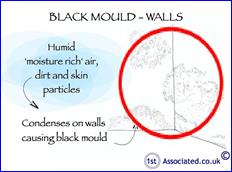
Black mould on walls caused by
condensation
The condensation problem overview
Since the 1970's our client has been living in this property as a tenant and ever since he had known it there had been mouldy patches in several of the rooms, although he had complained on and off to his landlord and various things had happened over the years (as we will explain), but nothing would solve the damp patch problem. It was only with the arrival of his new wife that they really became a problem! This ultimately resulted in us being called in to give independent advice.
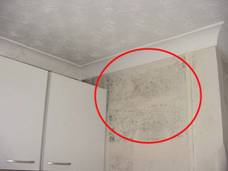
Black mould on walls
The house with condensation
The house was built circa 1914 (or that is the date on the hopper head). It is a semi-detached property with surrounding gardens. It is constructed as follows:
1. A rendered chimney
2. A pitched hipped roof clad in concrete tiles
3. A painted render wall
4. Modern plastic windows (with trickle vents)
5. A suspended timber ground floor
6. Joists and floorboards to the first floor
7. Rear extension, which has a concrete floor, a flat roof and is built in brick
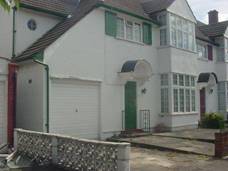
Extended rendered property with
plastic windows and a concrete tiled
roof
Mould to the render a close up look
First of all we examined the outside of the property, which showed within the render several things. There was mould to the rear left hand corner at the bottom of the single storey extension and there was mould just above the single storey extension in the main building, where it met the single storey extension. Other than that the render looked in reasonable condition apart from some hairline cracking. Whilst hairline cracking can allow dampness into a property, in this case it was surface level and we believe was caused by the plastic double glazed windows being inserted into the property and whilst the render on the surface moved the plastic windows did not and this caused the cracking. This is why you should have windows appropriate for the buildings age and type and construction, not to mention the aesthetics.
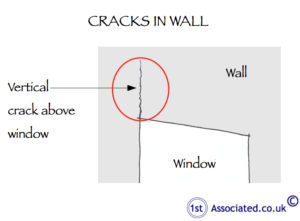
Cracks in render above window
So, considering the mouldy render in the two areas identified we then looked for leaking gutters, downpipes and soil and vent pipes in the area. Whilst we suspected there was some leakage in these areas, as we could see rusting and some cracking to the gutters and downpipes, we didn't think this was sufficient to cause the mould, but we did note that the flat roofed single storey extension had an edge of the flat roof that if it allowed rainwater over would come down the face of the side where the mould was. This was impossible to see at ground level, although in theory it shouldn't have been as the guttering is to the adjacent side and the floor should have been away from this area. Nevertheless, we used a ladder to get up onto the roof and checked. We found that the flat roof did have a reasonable fall on it and also there was no damage or major deterioration to the flat roof that would cause such a problem.

Rust on the soil and vent pipe could
mean its leaking onto render
The inside inspection of the property
Dampness at ground floor level that is causing the mould was in the ground floor bathroom and at first floor level was in the rear bedroom.
Ground floor bathroom dampness
As this area was on the ground floor we did a check for rising damp and did find damp to the side wall but not to the rear wall (the rest of the walls were internal and they didn't have any signs of dampness). Therefore rising damp could definitely be a cause of the dampness, or a contributory factor.
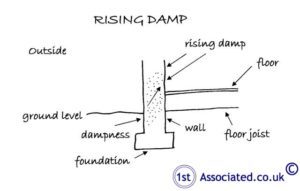
Rising damp
Is the bathroom ventilated sufficiently?
To the exterior of the property on the extension we noted two vents; one at high level and one at low level. These would be sufficient for most bathrooms of this size, however, when we went inside to inspect these areas we found that the low level vent had been covered over by a radiator (not good planning) and meant that the amount of ventilation in the room was not sufficient. This therefore is an additional contributory factor to the mould.
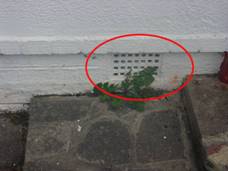
Low level air brick vent
Ventilation to the windows
Another important area to look with regard to ventilation is the windows to see how large the opening panels of the windows are, or if they are fixed windows. In this case the windows were casement windows with half of them being able to open. This doesn't mean that people open them but it does mean that option is available. We also noted that the windows have a trickle vent, which means that, providing the trickle vent is open, there will always be a flow of air in the area.
Trickle Vents Defined
Small vents to the windows to allow air movement inside the property to stop a build up of fumes or humidity.
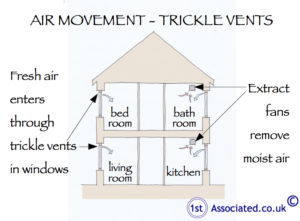
Trickle vents and air movement
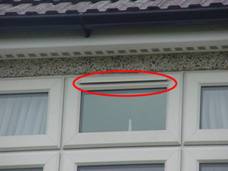
Window with trickle vent
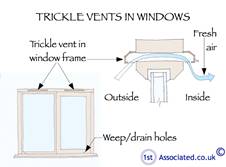
Trickle vent
Examining the mould
The mould at the time of our inspection, which was in the summer, was relatively minor, but during our question and answer session with the occupier they advised that it was far worse during some periods of the year and it was relatively minor at present.
Interestingly, the actual examination of the mould is not about how black the mould was but was more about its location and height.
So, is this condensation, penetrating damp or something else?
We would say that part of it is rising damp but the majority of it is condensation. One point we haven't mentioned is the surface finish. In this instance the surface finish was not a plaster but a hard cement render with a plastic based paint upon it. These tend to sweat and contribute towards condensation.
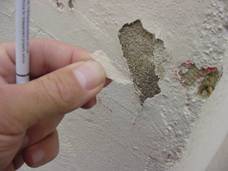
This appears to be a plastic/polymer
based paint on a hard cement render
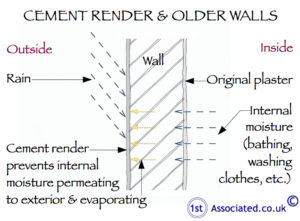
Cement render on older walls can cause
dampness
What is the remedy?
In this instance the remedy is to add more ventilation, both in the form of an air vent, which vents naturally, and in the form of a mechanical vent. We also needed to educate/advise the owners to open their windows more frequently, particularly when taking a long shower or bath and if any clothes need drying on wet days to use other suitable areas, rather than the ground floor bathroom.

Air brick
We have written many surveying articles about dampness and other property problems that may be of help to you
Independent Surveyors
Our Building Surveyors can also provide independent expert opinion with regard to valuations, mortgages, mortgage companies, surveys, building surveys, engineers reports, specific defects report, structural surveys, home buyers reports or any other property matters please contact 0800 298 5424 for a surveyor to give you a call back.
What do the ovals and circles in our surveys mean?
When you read our Building Survey reports you will notice circles and ovals on some of the photos and sketches. This is a system that we use to highlight problem areas to explain to you what the issues are within the property.
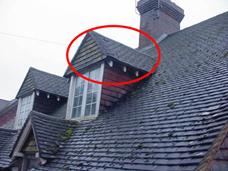
Dormer windows can cause cold
bridging and condensation if poorly
insulated
Our Survey Sketches
In addition to the photos, ovals and circles we also use our own sketches, such as the example that is shown here, to help to explain the problems further.
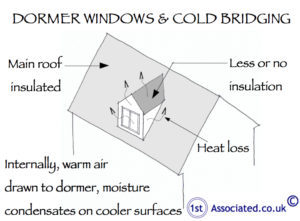
Cold bridging and dormer window
Our Good, Bad and Ugly surveys!
We would also like to introduce to you what we call our good, bad and ugly survey which is our residential building survey, also sometimes known as a structural survey. After listening to the feedback from clients we have designed this survey and report to be easy to understand and we have been written it in plain English.
Examples of our building surveys
If you have dampness problems or other property issues and would like to see examples of our surveys, either residential or commercial, we are more than happy to provide you with these via email. You will see that our surveys contain photos, sketches and definitions that help to explain the specific problems that we find within the property.
Commercial Property
If you have a commercial property, whether it is freehold or leasehold then sooner or later you may get involved with dilapidation claims. You may wish to look at our Dilapidations Website at www.DilapsHelp.com and for Disputes go to our Disputes Help site www.DisputesHelp.com
We hope you found the article of use and if you have any experiences that you feel should be added to this article that would benefit others, or you feel that some of the information that we have put is wrong then please do not hesitate to contact us (we are only human).
The contents of the website are for general information only and are not intended to be relied upon for specific or general decisions. Appropriate independent professional advice should be paid for before making such a decision.
All rights are reserved the contents of the website are not to be reproduced or transmitted in any form in whole or part without the express written permission of www.1stAssociated.com

